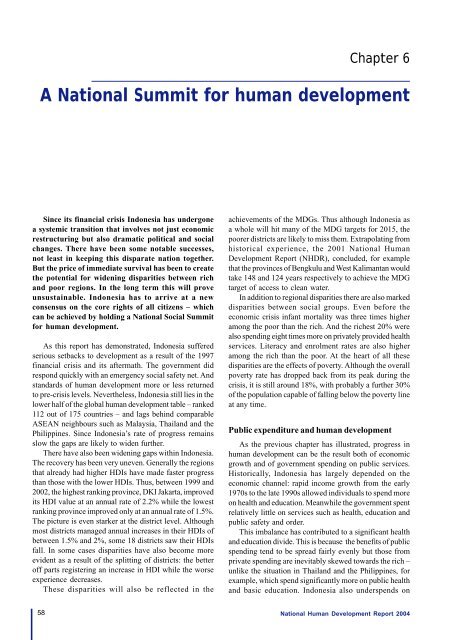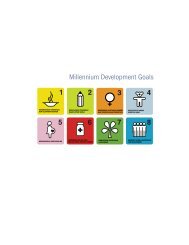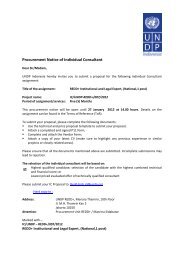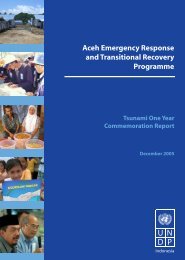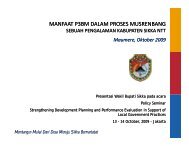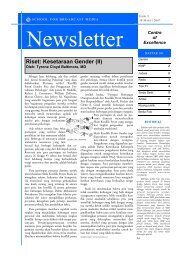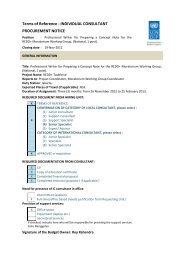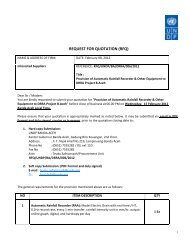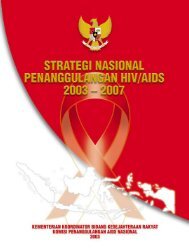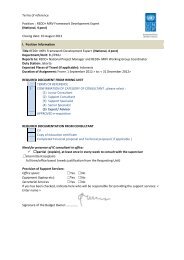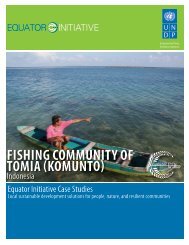Download the Indonesia Human Development Report 2004. - UNDP
Download the Indonesia Human Development Report 2004. - UNDP
Download the Indonesia Human Development Report 2004. - UNDP
You also want an ePaper? Increase the reach of your titles
YUMPU automatically turns print PDFs into web optimized ePapers that Google loves.
Chapter 6A National Summit for human developmentSince its financial crisis <strong>Indonesia</strong> has undergonea systemic transition that involves not just economicrestructuring but also dramatic political and socialchanges. There have been some notable successes,not least in keeping this disparate nation toge<strong>the</strong>r.But <strong>the</strong> price of immediate survival has been to create<strong>the</strong> potential for widening disparities between richand poor regions. In <strong>the</strong> long term this will proveunsustainable. <strong>Indonesia</strong> has to arrive at a newconsensus on <strong>the</strong> core rights of all citizens – whichcan be achieved by holding a National Social Summitfor human development.As this report has demonstrated, <strong>Indonesia</strong> sufferedserious setbacks to development as a result of <strong>the</strong> 1997financial crisis and its aftermath. The government didrespond quickly with an emergency social safety net. Andstandards of human development more or less returnedto pre-crisis levels. Never<strong>the</strong>less, <strong>Indonesia</strong> still lies in <strong>the</strong>lower half of <strong>the</strong> global human development table – ranked112 out of 175 countries – and lags behind comparableASEAN neighbours such as Malaysia, Thailand and <strong>the</strong>Philippines. Since <strong>Indonesia</strong>’s rate of progress remainsslow <strong>the</strong> gaps are likely to widen fur<strong>the</strong>r.There have also been widening gaps within <strong>Indonesia</strong>.The recovery has been very uneven. Generally <strong>the</strong> regionsthat already had higher HDIs have made faster progressthan those with <strong>the</strong> lower HDIs. Thus, between 1999 and2002, <strong>the</strong> highest ranking province, DKI Jakarta, improvedits HDI value at an annual rate of 2.2% while <strong>the</strong> lowestranking province improved only at an annual rate of 1.5%.The picture is even starker at <strong>the</strong> district level. Althoughmost districts managed annual increases in <strong>the</strong>ir HDIs ofbetween 1.5% and 2%, some 18 districts saw <strong>the</strong>ir HDIsfall. In some cases disparities have also become moreevident as a result of <strong>the</strong> splitting of districts: <strong>the</strong> betteroff parts registering an increase in HDI while <strong>the</strong> worseexperience decreases.These disparities will also be reflected in <strong>the</strong>achievements of <strong>the</strong> MDGs. Thus although <strong>Indonesia</strong> asa whole will hit many of <strong>the</strong> MDG targets for 2015, <strong>the</strong>poorer districts are likely to miss <strong>the</strong>m. Extrapolating fromhistorical experience, <strong>the</strong> 2001 National <strong>Human</strong><strong>Development</strong> <strong>Report</strong> (NHDR), concluded, for examplethat <strong>the</strong> provinces of Bengkulu and West Kalimantan wouldtake 148 and 124 years respectively to achieve <strong>the</strong> MDGtarget of access to clean water.In addition to regional disparities <strong>the</strong>re are also markeddisparities between social groups. Even before <strong>the</strong>economic crisis infant mortality was three times higheramong <strong>the</strong> poor than <strong>the</strong> rich. And <strong>the</strong> richest 20% werealso spending eight times more on privately provided healthservices. Literacy and enrolment rates are also higheramong <strong>the</strong> rich than <strong>the</strong> poor. At <strong>the</strong> heart of all <strong>the</strong>sedisparities are <strong>the</strong> effects of poverty. Although <strong>the</strong> overallpoverty rate has dropped back from its peak during <strong>the</strong>crisis, it is still around 18%, with probably a fur<strong>the</strong>r 30%of <strong>the</strong> population capable of falling below <strong>the</strong> poverty lineat any time.Public expenditure and human developmentAs <strong>the</strong> previous chapter has illustrated, progress inhuman development can be <strong>the</strong> result both of economicgrowth and of government spending on public services.Historically, <strong>Indonesia</strong> has largely depended on <strong>the</strong>economic channel: rapid income growth from <strong>the</strong> early1970s to <strong>the</strong> late 1990s allowed individuals to spend moreon health and education. Meanwhile <strong>the</strong> government spentrelatively little on services such as health, education andpublic safety and order.This imbalance has contributed to a significant healthand education divide. This is because <strong>the</strong> benefits of publicspending tend to be spread fairly evenly but those fromprivate spending are inevitably skewed towards <strong>the</strong> rich –unlike <strong>the</strong> situation in Thailand and <strong>the</strong> Philippines, forexample, which spend significantly more on public healthand basic education. <strong>Indonesia</strong> also underspends on58National <strong>Human</strong> <strong>Development</strong> <strong>Report</strong> 2004


